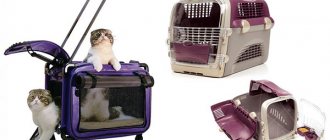Anastasia Dmitrievna Mitryaykina
veterinarian Petstory
Normal temperature in cats is one of the most important indicators of health. Changes in body temperature, up or down, can significantly affect your pet's health, and sometimes the consequences can be fatal.
- Heat
Factors affecting temperature
Age
Before the age of 10 days (neonatal period), kittens cannot independently maintain their body temperature. They are heated by the warmth of the mother or other external sources (heating pads). The normal body temperature of a newborn kitten is from 35 to 36 degrees, but it also directly depends on the temperature in the nest.
If there is no mother, or for some reason she does not care for the offspring, the owner will have to take care of the babies. Place heating pads in the nest. If it is electric, then select the weakest mode on it. If you place water in a bottle, then its temperature should be about 40 degrees. Cover the bottle with several layers of blankets. If you are using a red lamp, it is important to place the thermometer at the warmest point. The temperature should not exceed 30 degrees, otherwise the babies may overheat.
By the age of one month, a kitten’s temperature of 38 degrees is considered normal. Further, adult animals have a normal temperature; it can fluctuate depending on various factors, but always remains within the range of 37.5–39 degrees. Older pets tend to be less active and their body temperature rarely exceeds 38 degrees Celsius.
Activity
In general, if a furry couch potato is calm, its temperature will be lower than that of an active and cheerful cat, such as an Abyssinian or Burmese breed.
Times of Day
In the morning the result is usually lower than in the afternoon. The cat is a twilight predator, and all its vital processes occur more actively in the evening.
Overweight
Overweight animals usually have a lower body temperature than moderately well-fed animals.
Specialized assistance
The best solution when identifying signs of hypothermia in a pet is to contact a veterinarian. It is necessary to find out the cause of the disease in an animal rescued from the street and in your cat, and carry out a number of diagnostic measures:
- Examination by a specialist.
- Collection of tests.
- X-ray of the chest and abdominal organs.
- Ultrasound examination of the abdominal organs.
- X-ray of skeletal bones.
Depending on the severity of the condition, when examining the animal, the doctor will detect a decrease in heart rate, an irregular heart rhythm, a decrease in blood pressure, a decrease in the amount of urine excreted, changes in breathing - it becomes superficial and rare. The animal reacts sluggishly or not at all to inspection; consciousness may be absent.
In severe cases, breathing practically stops, single breaths appear, foam may appear at the mouth (a sign of pulmonary edema), lack of consciousness, pulse and blood pressure may be barely noticeable or not detectable.
The doctor prescribes intravenous infusions with warm solutions, medications that relieve symptoms of the underlying disease, and oxygen therapy. The clinic staff constantly monitors the cat’s vital signs.
For more severe hypothermia, internal warming is performed: the stomach is washed with warm solutions, enemas with heated solutions, and inhalation of warm air.
In case of clinical death, the animal begins to be resuscitated immediately. If the measures are not successful, the death of the animal can be declared if the body temperature is above 30 – 32°C. Surviving patients, especially old ones, may have consequences in the form of impaired brain function, a shift in the point of thermoregulation, and cardiovascular failure. Some experts believe that animals that have experienced severe hypothermia are more likely to experience repeated episodes of hypothermia.
Table with standards
| T/age | Up to 10 days | 10–30 days | month–10 years | Older |
| 35–37 | norm | normal/reduced | downgraded | downgraded |
| 37–38 | normal/increased | norm | downgraded | reduced/normal |
| 38–39 | Promoted | increased/normal | norm | norm |
| more than 39 | Promoted | increased | increased | increased |
Reasons for temperature deviation from normal
Heat
Basically, when people talk about fever in cats, they mean hyperthermia.
Such a nuisance can occur for many reasons, but mainly it is due to the body's reaction to inflammation or pain. Elevated ambient temperatures, prolonged exposure to hot rooms or direct sunlight can cause hyperthermia. If your cat has a high temperature, stress may also be the cause.
Low temperature
Hypothermia can be noted in cats in a state of general loss of strength and dehydration, and in small kittens - if they are left without an external source of heat. If your cat has a low temperature, it may be due to hypothermia.
Causes of hypothermia
There are many reasons for hypothermia:
- Hypothermia. A common cause for cats that walk outside. The temperature decreases due to the physical transfer of heat to the external environment. Frostbite can be an additional problem.
- Infectious or viral disease. There are two possible developments. The first option is a slowdown in metabolism (as a result of intoxication). The second option is inflammation of the brain, hypothalamus (responsible for temperature). Often accompanied by symptoms such as diarrhea, cough, shortness of breath.
- Low blood pressure. Because of this, the oxygen supply to tissues deteriorates. As a result, metabolism slows down and temperature drops. A decrease in pressure is easily determined by a tonometer.
- Starvation. Because of it, metabolism slows down and temperature decreases. With severe exhaustion, other symptoms appear: cardiovascular disorders, alopecia, weight loss, and in severe cases, atrophy of internal organs and muscles.
- Anesthesia. Because of it, the temperature drops, as the brain turns off, along with the hypothalamus and the thermoregulation center. After the animal comes to its senses, the symptoms disappear, but with deep and long-term anesthesia, medical assistance will be required.
- Cancer. Because of this, the main part of the nutrients goes not to healthy cells, but to tumor cells. Due to a deficiency of substances, metabolism and temperature drop. More often, such signs appear in the later stages, when the main problem is not hypothermia, but metastases.
- Kidney diseases. Intoxication leads to metabolic disorders and a decrease in temperature. Often the disease is accompanied by problems with the liver, urination, and cardiovascular system.
- Heavy bleeding. As a result, blood pressure drops, oxygen supply to tissues deteriorates, metabolism slows down, and temperature drops. Additional signs are anemia and bleeding itself.
- Metabolic disorders. It becomes a consequence of a deficiency of various vitamins, amino acids, fats and minerals. Alopecia, stunted growth, curvature of bones, and cardiovascular disorders are often added to the symptoms.
- Vitamin deficiency. As a result, metabolism is disrupted. This leads to a decrease in metabolism. Additional symptoms include alopecia, curvature of bones, digestive and urinary problems.
- Poisoning. They lead to a wide variety of consequences. Often accompanied by diarrhea, vomiting, cardiovascular and respiratory disorders, and pathologies of the nervous system.
- Dehydration. The decline begins with severe dehydration, when blood pressure drops. Additional symptoms are dry mucous membranes, sunken eyes, lack of shine in the coat, and weakness.
- Heart diseases. Because of them, blood circulation is disrupted and the supply of oxygen to tissues is reduced. This is often accompanied by low blood pressure, chest pain, swelling, and blue discoloration of the mucous membranes.
- Enteritis. The temperature drops in severe cases, when the integrity and function of the intestine is severely impaired, cardiovascular pathologies, intoxication, and dehydration appear.
- Diseases of the nervous system. Hypothermia appears if the hypothalamus and thermoregulation center are involved in the pathological process. Often accompanied by a variety of abnormalities in the functioning of the central nervous system.
How can you tell if your cat has a fever?
Signs of general malaise in your furry friend should always be cause for concern. The most important indication that a pet’s body temperature should be measured is a change in its behavior: decreased activity, refusal of usual play, desire to hide. You may also notice that your cat has become worse at eating or has completely abandoned its usual food.
Without thermometry, it is impossible to know whether there is a temperature.
There is a well-established belief that if a pet has a dry and warm nose, it has a fever. But if it’s wet and cold, then everything is fine. In fact, even a completely healthy cat can have a dry and warm nasal mucosa, for example, after sleep. You should not pay attention to this sign, and if in doubt, you need to measure the temperature rectally.
Thermoregulation
The mechanism of maintaining body temperature in the body at a constant level is called thermoregulation. The thermoregulation center is located in an area of the brain called the hypothalamus. The norm for a cat's body temperature is set between 38 and 39 degrees Celsius. The hypothalamus compares its temperature with the data it receives through nerve impulses from receptors on the skin.
When the surface temperature of the body increases, for example in hot weather, the hypothalamus will take measures to reduce it. To achieve this, body heat transfer will be increased. The blood vessels located close to the skin will dilate to cool the blood. Additionally, the paw pads may become damp.
When the body surface temperature decreases (for example, in cold weather), the hypothalamus will try to increase it. To achieve this, a spasm will be produced, i.e. constriction of blood vessels on the surface of the body, rise of hair, decreased breathing rate. In addition, the cat curls up into a ball to minimize body heat loss.
These thermoregulation processes are normal and occur when environmental conditions change.
How to measure body temperature in cats at home?
Many cats experience stress when leaving their familiar home, and going to the veterinary clinic can be a real ordeal for these animals. Therefore, sometimes the owner may need to independently measure the pet’s body temperature at home.
It is important to remember that ensuring the safety of all participants in the process is your direct responsibility. Therefore, if in doubt, it is better to entrust the procedure to professionals. In any case, do not try to perform weighted manipulations.
Use a bag, muzzle and collar to restrain your cat and protect it from its claws and teeth. If you don’t have these devices, try to carefully swaddle the cat with a towel or blanket. Involve an assistant in the procedure. Don't frighten the patient. It is better to measure an animal's body temperature rectally - with an electronic or mercury thermometer.
Hurry up, choose a box and find out what gift awaits you
Discount on pet insurance
Promo code copied to clipboard
Measurement with a children's electronic thermometer
The best option for measuring body temperature in cats is to do it rectally. The children's electronic thermometer is atraumatic (flexible, soft), has a small tip, and is easy to handle. To measure an animal's temperature with it:
- treat the tip of the thermometer with an antiseptic;
- apply any fatty cream or ointment to the tip;
- insert the tip of the thermometer rectally (no more than 1.5 cm);
- wait for the sound signal;
- remove carefully;
- re-treat the thermometer with an antiseptic.
Measuring temperature with a mercury thermometer
This method gives a more accurate result, but it will take longer and more reliably to fix the patient, since it is more traumatic. It partially repeats the measurement described above:
- treat the tip of the thermometer with an antiseptic;
- apply any fatty cream or ointment to the tip;
- insert the tip of the thermometer rectally (no more than 1.5 cm);
- wait 6 minutes;
- carefully remove the tip of the thermometer;
- re-treat the thermometer with an antiseptic.
Infrared thermometer
can be used by applying from the inner surface of the ear. But the error of such a measurement is quite large, and it cannot be considered accurate.
What to do if cats have a fever?
First of all, it is worth noting that the result of changes in body temperature in cats is not as important as the patient’s well-being.
This means that if the pet is cheerful, active, plays, has an excellent appetite, and an increase in body temperature
insignificantly, he needs to be provided with gentle treatment and special conditions. This means being in a comfortable, well-ventilated room, unlimited access to fresh drinking water and peace. It is necessary to observe the animal and repeat the measurements no earlier than half an hour later. If the cat is lethargic, not as playful as usual, is not interested in what is happening, refuses to eat, or you notice other symptoms (vomiting, diarrhea, itching), then this is a reason to immediately consult a veterinarian.
If hyperthermia is associated with external factors, they, of course, need to be eliminated - ventilate the room, turn on the air conditioning. You can wet your paws, belly and head with water at room temperature.
Under no circumstances should you try to reduce the temperature yourself. The use of some “human” antipyretics (for example, paracetamol) can lead to the death of a cat.
If you experience hypothermia
cats, but she feels fine, try to provoke her into active actions - play with her, feed her, replace the thermometer. Repeat the measurements.
If your cat is cold, place her in a warm place with a heating pad nearby (if you don't have one, wrap hot water bottles in towels).
It is worth mentioning separately that a decrease in temperature is a common consequence of anesthesia and muscle relaxation. This condition can be life-threatening, so until all indicators are completely stabilized, it is better to leave the animal under the supervision of specialists. If you take the patient home, strictly follow the recommendations of the attending physician.
Thus, a significant and persistent change in a cat’s body temperature is always a reason to seek help from specialists.
Antipyretic for cats
If our advice did not help you, and you do not know how to lower your cat’s temperature before the veterinarian arrives, call the doctor, maybe he will allow you to use antipyretics before his visit. The main rule is to never give human medications to cats.
A cat's temperature can be reduced with the following medications:
- Tsefekon - candles.
- Papaverine and diphenhydramine - injections.
- Echinacea – tincture.
- Meloxicam - tablets.
All these drugs, as well as others, can be given only on the recommendations of the treating specialist.










